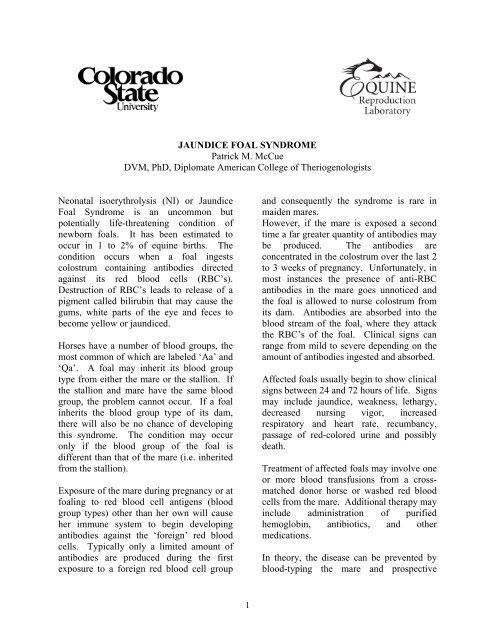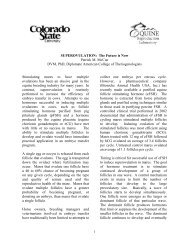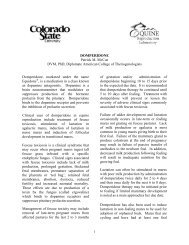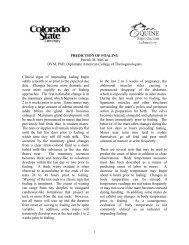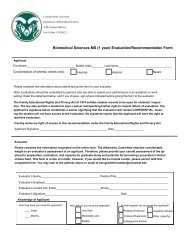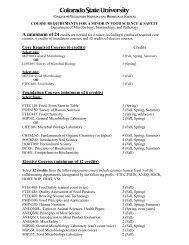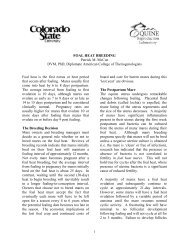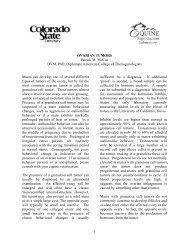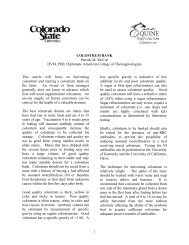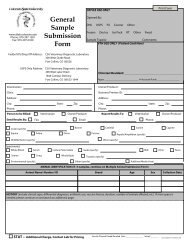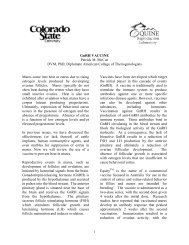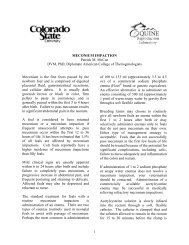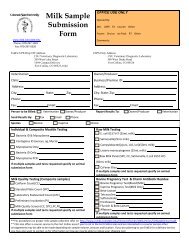JAUNDICE FOAL SYNDROME Patrick M. McCue DVM, PhD ...
JAUNDICE FOAL SYNDROME Patrick M. McCue DVM, PhD ...
JAUNDICE FOAL SYNDROME Patrick M. McCue DVM, PhD ...
You also want an ePaper? Increase the reach of your titles
YUMPU automatically turns print PDFs into web optimized ePapers that Google loves.
<strong>JAUNDICE</strong> <strong>FOAL</strong> <strong>SYNDROME</strong><strong>Patrick</strong> M. <strong>McCue</strong><strong>DVM</strong>, <strong>PhD</strong>, Diplomate American College of TheriogenologistsNeonatal isoerythrolysis (NI) or JaundiceFoal Syndrome is an uncommon butpotentially life-threatening condition ofnewborn foals. It has been estimated tooccur in 1 to 2% of equine births. Thecondition occurs when a foal ingestscolostrum containing antibodies directedagainst its red blood cells (RBC’s).Destruction of RBC’s leads to release of apigment called bilirubin that may cause thegums, white parts of the eye and feces tobecome yellow or jaundiced.Horses have a number of blood groups, themost common of which are labeled ‘Aa’ and‘Qa’. A foal may inherit its blood grouptype from either the mare or the stallion. Ifthe stallion and mare have the same bloodgroup, the problem cannot occur. If a foalinherits the blood group type of its dam,there will also be no chance of developingthis syndrome. The condition may occuronly if the blood group of the foal isdifferent than that of the mare (i.e. inheritedfrom the stallion).Exposure of the mare during pregnancy or atfoaling to red blood cell antigens (bloodgroup types) other than her own will causeher immune system to begin developingantibodies against the ‘foreign’ red bloodcells. Typically only a limited amount ofantibodies are produced during the firstexposure to a foreign red blood cell groupand consequently the syndrome is rare inmaiden mares.However, if the mare is exposed a secondtime a far greater quantity of antibodies maybe produced. The antibodies areconcentrated in the colostrum over the last 2to 3 weeks of pregnancy. Unfortunately, inmost instances the presence of anti-RBCantibodies in the mare goes unnoticed andthe foal is allowed to nurse colostrum fromits dam. Antibodies are absorbed into theblood stream of the foal, where they attackthe RBC’s of the foal. Clinical signs canrange from mild to severe depending on theamount of antibodies ingested and absorbed.Affected foals usually begin to show clinicalsigns between 24 and 72 hours of life. Signsmay include jaundice, weakness, lethargy,decreased nursing vigor, increasedrespiratory and heart rate, recumbancy,passage of red-colored urine and possiblydeath.Treatment of affected foals may involve oneor more blood transfusions from a crossmatcheddonor horse or washed red bloodcells from the mare. Additional therapy mayinclude administration of purifiedhemoglobin, antibiotics, and othermedications.In theory, the disease can be prevented byblood-typing the mare and prospective1
stallion(s) and avoiding breeding a marewithout the blood groups ‘Aa’ or ‘Qa’ to astallion with those blood groups. However,this is not very practical.It is far easier to test the blood of broodmares in the last 1 to 3 weeks of gestationfor the presence of antibodies against thecommon red blood cell antigens. If nopotentially offending antibodies are detected,the risk of development of NI is extremelylow. However, if antibodies against one ormore RBC antigens are present in the bloodof the mare, the foal could be at risk ofdeveloping NI if allowed to nurse colostrumfrom the mare. The NI screening test isavailable through several diagnosticlaboratories around the country.Consequently, if a mare has had a foalaffected by NI in the past, or if she is foundto have antibodies in her blood against otherequine blood groups, the newborn foalshould not be allowed to nurse from her andshould be provided colostrum or antibodiesfrom another known safe source. The foalcan be muzzled to prevent nursing and yetstill allowed to remain with the mare. Thecolostrum of the mare should be stripped outevery few hours and discarded. Afterapproximately 36 hours, the mammary glandof the mare will no longer be producingcolostrum and the foal can no longer absorbantibodies if they were present. The muzzlecan then be safely removed and the foalallowed to nurse from the dam. It is criticalthat initially colostrum and then later on analternative nutrition supply (i.e. mare milkreplacer or goat’s milk) be provided to thefoal during the 36-hour period.Consultation with your equine veterinariancan help with further understanding of thecause and medical implications of thedisease, diagnostic tests, and preventionplans. As with many diseases, earlyrecognition and treatment are the keys tosurvival.Photo of a foal wearing a muzzle toprevent nursing2


